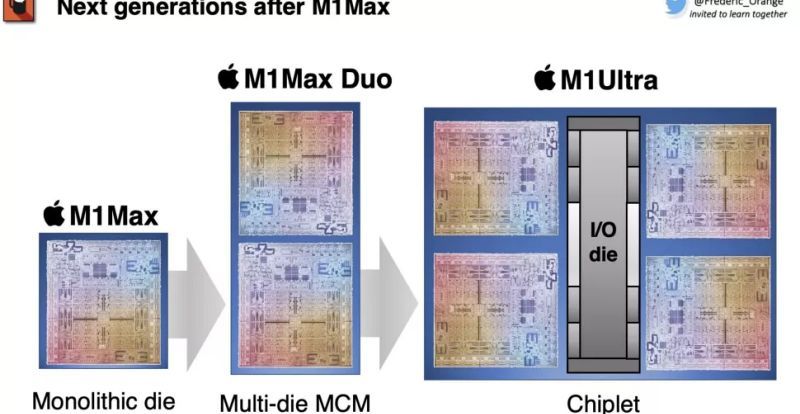Apple may have an ace up its sleeve with its M1 Max processors, recently introduced to power its Mac computers.
Apple M1 Max, images hint at future chiplet modules.
Can you guys see this, or am I just crazy? The actual M1 Max chip has a whole hidden area on the bottom that wasn’t seen at all in Apple’s official renderings of the M1 Max chip. Just flip another M1 Max over and plug it in to get an M1 Max Duo chip. Then use I/O cube for M1 Max Quadra. https://t.co/McWmofJAls pic.twitter.com/JogRwUGvF6
– Vadim Yuryev (@VadimYuryev) December 2, 2021
Images of the chip suggest Apple could adopt the chiplet design, as AMD did with Ryzen.
New images of the underside of the chip show that it could have an interconnect bus that allows multi-chip module (MCM) scaling.
If true, we could see M1 chips with up to 40 CPU cores and 128 GPU cores. The source claims that the configuration with two MCM modules could be called M1 Max Duo, while the configuration with 4 multi-chip modules would be called M1 Max Quadra.
The latest M1 Max chip unveiled by Apple has around 57 billion transistors with 10 CPU cores and 24 or 32 GPU cores and uses a 5nm node. An MCM (multi-chip) design could multiply or quadruple the number of cores and improve performance exponentially, although we would have to wait to improve the processing node to avoid “gigantic” chips.
In addition, the RAM would have to be doubled to 128 GB, which would also double the bandwidth to 800 Gb/s, always talking about the “Duo” model.
When we will see these chips in action is hard to say. It’s likely that Apple will start using this technology in 2023 when the entire Mac lineup will be revamped.
Unlike Apple’s official renders, there is a larger portion of this chip’s edge section that is not shown in the renders. This user said that simply by flipping this chip over, it can be interconnected with the same chip to form an MCM multi-chip package architecture to further improve performance.
Apple’s current M1 Max chip contains 10 CPU cores, 24 or 32 GPU cores, and is manufactured using TSMC’s 5nm process with a whopping 57 billion transistors. If Apple’s chip can be packaged together in multiple pieces, it promises to deliver even more performance and save on development costs, eliminating the need for redesign.
Only the M1 Max has been found to have additional integrated circuits for interconnects, while no hidden parts of the M1 Pro series chips have been found, and the actual photos of the cores are consistent with the official renders.
If the Apple M1 Max chip can be implemented in a multi-chip package, it will be able to support 128GB of memory and the memory bandwidth can be expanded to 800Gb/s, which can be used for purposes such as graphics workstations while consuming significantly less power compared to traditional solutions.
